
2000 AD is a weekly British science fiction-oriented comic magazine. As a comics anthology it serialises stories in each issue and was first published by IPC Magazines in 1977, the first issue dated 26 February. Since 2000 it has been published by Rebellion Developments.

Hawkman is the name of several superheroes appearing in American comic books published by DC Comics. Created by writer Gardner Fox and artist Dennis Neville, the original Hawkman first appeared in Flash Comics #1, published by All-American Publications in 1940. Over the course of the character's publication history, due to a series of reinventions of the character following the 1985 Crisis on Infinite Earths crossover and series, Hawkman is known as having one of the most confusing backstories of any character in DC Comics.

Zenith is a British superhero, who appeared in the British science fiction comic 2000 AD. Created by writer Grant Morrison and artist Steve Yeowell, with original character designs by Brendan McCarthy, the story first appeared in 2000 AD #535. Zenith himself did not appear until the second episode – the first episode set the backdrop for his introduction.

Tornado was a British weekly boys' adventure comic published by IPC Magazines from 24 March to 18 August 1979. The comic was partly created as a way to use up stories already commissioned for the other titles, and was marred by a difficult production. Tornado sold poorly and was merged with 2000 AD after 22 issues.

Tiger was a weekly British comics periodical published by Amalgamated Press, Fleetway Publications and IPC Magazines from 11 September 1954 to 30 March 1985. The title was initially launched in a large tabloid size to mimic newspapers; while it featured some action-adventure stories Tiger contained a large number of sport strips. The most famous of these was "Roy of the Rovers", which debuted in the first issue and was the comic's most popular feature, eventually transferring to its own comic in 1975. Tiger would go on to become one of the company's longest-running titles, with 1,573 issues published before being merged with Eagle in 1985. Over the course of its run, Tiger featured columns by numerous famous sports figures, including Ian Botham, Geoff Boycott, Tony Greig, Trevor Francis and Charlie Nicholas.
Michael Anglo was a British comic book writer, editor and artist, as well as an author. He was best known for creating the superhero Marvelman, later known as Miracleman.
Black Condor is the superhero name used by three different fictional characters in the DC Comics universe. All three incarnations of Black Condor have been members of the Freedom Fighters and each has been featured in Freedom Fighters comic books published by DC Comics.
Lloigor is a fictional deity and a fictional race in the Cthulhu Mythos. The entity first appeared in August Derleth and Mark Schorer's short story "The Lair of the Star Spawn" (1932), and has been used in subsequent fictional works by others though often departing from the original concept. The Lloigor are also referred to as the Many-Angled Ones, apparently beginning with Grant Morrison's Zenith, and some subsequent works use variations on this term in lieu of the name Lloigor.

Denis Gifford was a British writer, broadcaster, journalist, comic artist and historian of film, comics, television and radio. In his lengthy career, he wrote and drew for British comics; wrote more than fifty books on the creators, performers, characters and history of popular media; devised, compiled and contributed to popular programmes for radio and television; and directed several short films. Gifford was also a major comics collector, owning what was perhaps the largest collection of British comics in the world.
Bolt is the name of several unrelated fictional characters appearing in American comic books published DC Comics. Although the characters vary in being both superheroes and supervillains, some versions of the characters are related to one another.
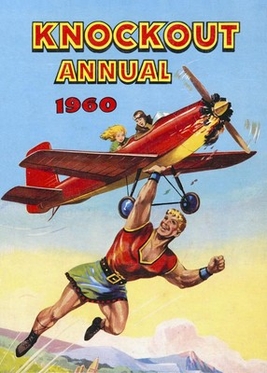
Thunderbolt Jaxon is a fictional Australian-British Golden Age comic book superhero. He first appeared in Thunderbolt Jaxon Comics #1, published in Australia by Amalgamated Press in 1949. While the character debuted in an Australian comic it was created by British staff working at Amalgamated Press' UK headquarters. The character has since appeared intermittently in British comics, and was revived by Wildstorm in 2006 for a five-issue mini-series written by Dave Gibbons with art by John Higgins.
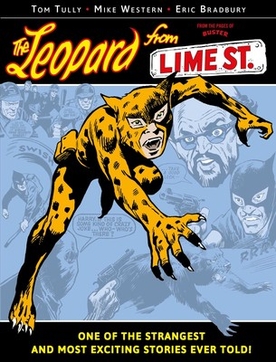
The Leopard from Lime Street was a comic strip appearing in the British comic Buster from 1976 to 1985. Written by Tom Tully, it was drawn in a 'realistic' comic style by Mike Western and Eric Bradbury, much like Marvel Comics's Spider-Man comic, in direct contrast to the stylized cartoony style of the rest of Buster.
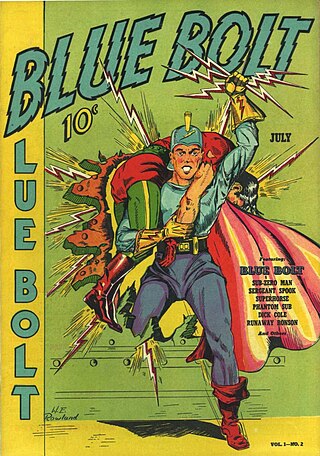
Blue Bolt is a fictional American comic book superhero created by writer-artist Joe Simon in 1940, during the period fans and historians refer to as the Golden Age of Comic Books.
The Twister is a fictional character, a comic book superhero who first appeared in Blue Bolt Comics from Novelty Press.
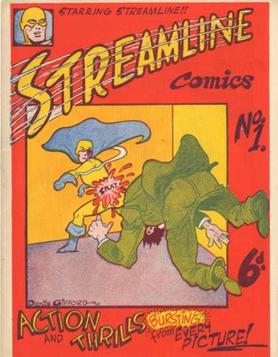
Streamline is a British Golden Age superhero, which appeared in the short-lived magazine Streamline Comics (1947), which only ran for four issues. The character was co-created by Denis Gifford and Bob Monkhouse, and later appeared as a character in the 2000 AD strip Zenith and the independent title Black Tower Comics Group Adventures.

Ace Hart is a fictional British Golden Age comic book superhero. He first appeared in Super Thriller Comic #6, published by Foldes Press of Edinburgh in 1948. While the character was created in-house none of the creators were credited and have yet to be identified.

The Amazing Three was a comic strip appearing in the British comic Jackpot from 1979 to 1980. While most of the rest of Jackpot consisted of humour strips The Amazing Three was closer to adventure material, though artist Trevor Metcalfe eschewed a realistic look for the artwork
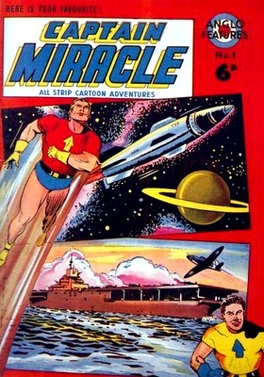
Captain Miracle is a fictional British Silver Age comic book superhero. The character was originally created by Mick Anglo for his own Anglo Features imprint, using material planned for Marvelman - itself a reworking of Fawcett Publications' Captain Marvel. The character first appeared in Captain Miracle #1, published in October 1960.
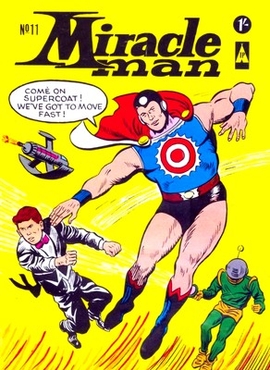
Miracle Man is a fictional British Silver Age comic book superhero. The character was originally created by Mick Anglo for Barcelona-based Spanish publisher Editorial Ferma in 1958 as Superhombre, running for 68 issues. In 1965 Anglo repurposed the character as Miracle Man for Thorpe & Porter, who released the monthly Miracle Man via their Top Sellers imprint between 1965 and 1966, running for 13 issues. While Miracle Man has a wide number of similarities with Anglo's earlier creation Marvelman, the strips were not redrawn versions of that character's adventures, although many covered similar themes.














